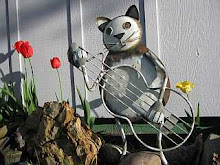With our recent global warming outbreak the ground thawed and I had a few days in which to dig out the old posts and put in new posts.
Here is after I dug out the rotted remainder of the fence post and got ready for a new post.
I replaced the rotted post with a used railroad tie. The two items to the left of the tie are also railroad ties but ones that have seen a lot of wear and age. Still, they are solid and are as good or better than many wooden fence posts. These smaller ties will be used to help brace the corner post. I also tossed in the pickup bed a couple of regular posts in case I needed them. I didn't.
This post didn't break off but as you can see it was pretty rotted. This rotted part was flexible and withstood the digging and pulling to get the post out of the ground.
It gets dark by 5 pm so that didn't leave much time to work on the fence for a few hours each afternoon after I finished a little more of the house remodel work
Monday: Remove original corner post. Complete digging out the hole for the new post as the hole is deeper (30+ inches) because the railroad ties are 8 1/2 ft long. Digging deeper meant digging in pure gravel. Just as digging in my corral water well resulted in the gravel sides sloughing off, so did these post holes. The lower half of the holes got wider the deeper I dug. Nightmare deja vu. Also find new posts and supporting stuff.
Tuesday: put in the railroad tie for new corner post, remove another old rotting post and dig a deeper hole for one of the supporting ties.
Wednesday: Finish putting the supporting ties in the ground, look for new connector boards as the ones I got earlier were too short once I determined the posts' location in order to make the cross support wires work, start attaching the connecting boards. Get another hammer as the wooden one I was using broke when I tried to pull out a stubborn nail. That is the third and the last of my "real" wood handle hammers. I will never buy another one. I am down to a steel handle hammer and the smaller - but tough - wood handle hammer my uncles deride. The steel hammer easily pulled out the stubborn nail.
Thursday: Finish attaching the connector boards and the cross wires, move a steel T post to a spot just left of the photo's edge, take apart the the end (last several post sections) of the fence on the left side and reattach the barb wires to the new posts. Also slowing me down is that I removed barbs from the last few feet of the old wires. Barbs aren't needed for the part of the wires that wrap around the corner railroad tie. No barbs made working with the wire around the post easier and worth the time spent removing them.
Friday: Finish the fence. Take apart the end (last several post sections) of the old fence on the right side, remove the rotted flexible post seen above, and reattach the barb wires to the new posts.
Those small boards attached the the corner post? Steps I can use to climb over the fence. I don't have a gate anywhere close to this location.
Now that the corner is done, next year rebuilding the rest of the hayfield fence along the road moves up in priority. The corner work is the hardest / most time consuming and is why I had delayed the rebuilding of the hayfield fence. The rest of the fence should go relatively quickly. Of course I have to be careful as once I rebuild this fence my uncles may not be able to find my ranch again without my unique fence.








No comments:
Post a Comment